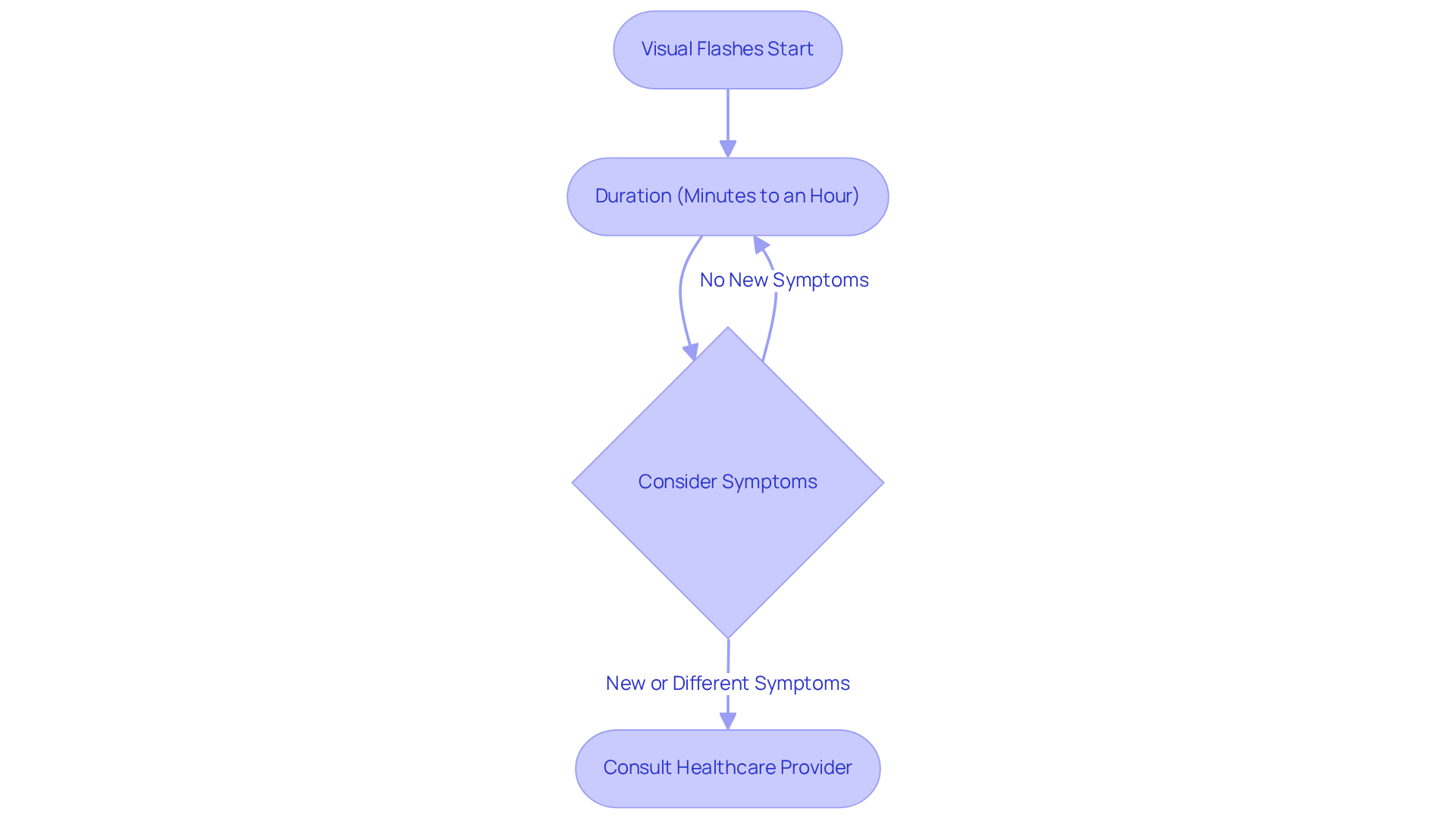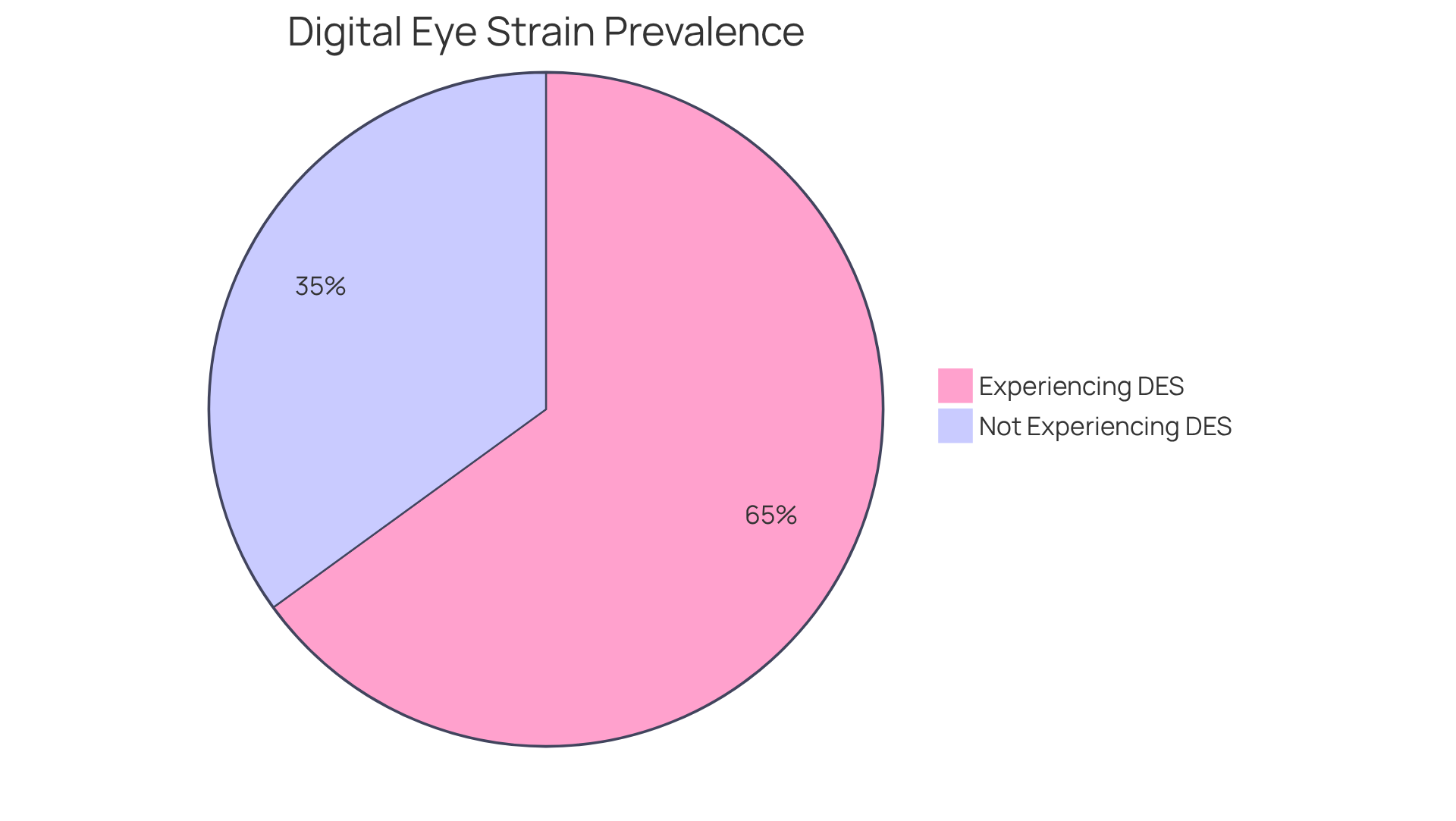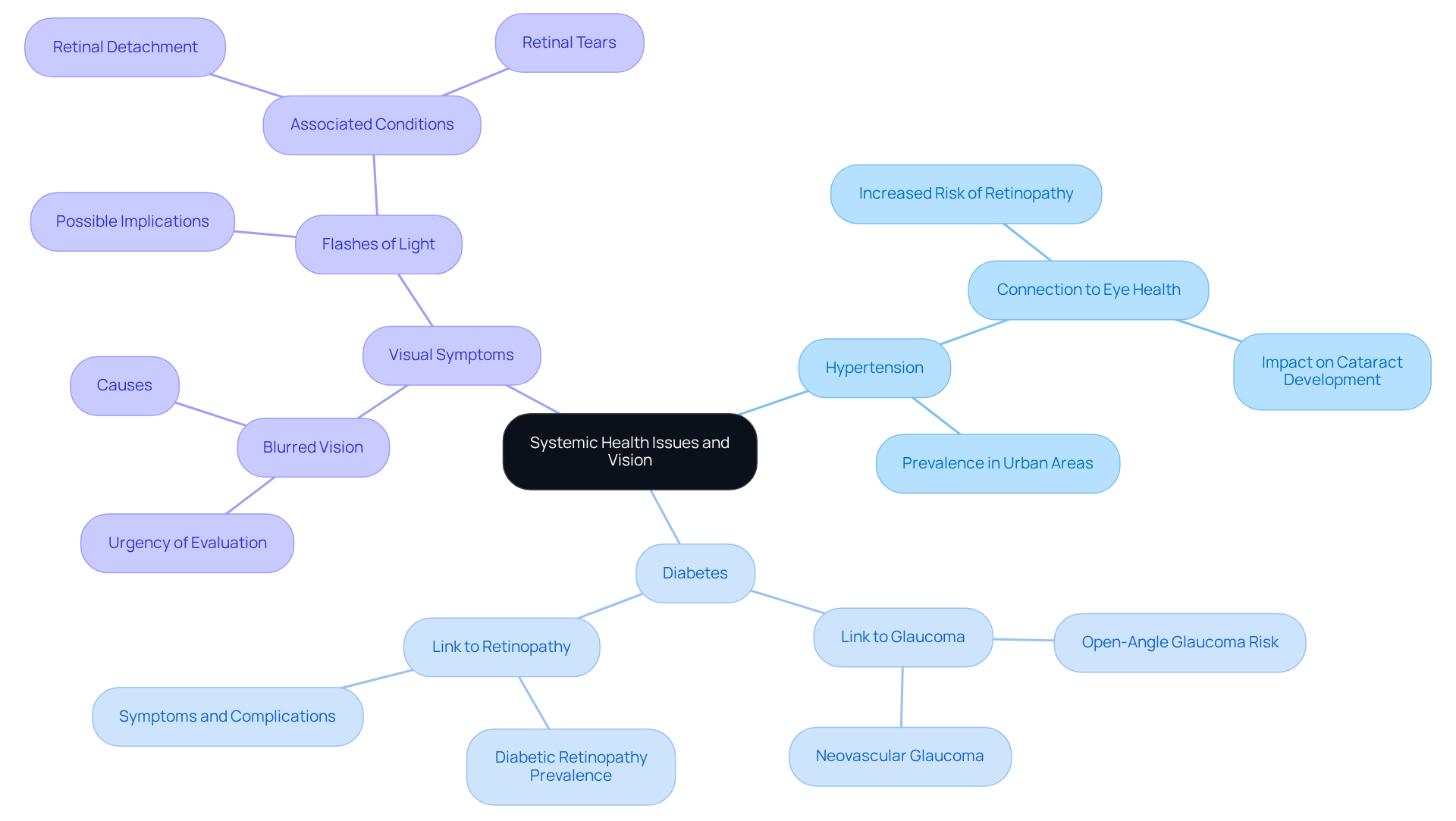Posted by: Northwest Eye in Cataract Surgery, Cataracts on November 7, 2025
Overview
If you’re experiencing flashes in your eye, especially as a cataract patient, it’s completely understandable to feel concerned. These flashes can stem from various conditions, including retinal detachment, migraine aura, vitreous detachment, eye strain, eye injuries, and even systemic health issues. Knowing the causes can help you feel more in control of your situation.
Research shows that timely medical intervention is crucial in preventing serious complications. For instance, retinal detachment can lead to significant vision loss if not addressed promptly. We understand that this information can be overwhelming, but it’s important to remember that you’re not alone in this journey.
Here are some key causes of flashes in the eye:
- Retinal Detachment: A serious condition that requires immediate attention.
- Migraine Aura: Often temporary, but can be alarming.
- Vitreous Detachment: Common as we age, but still worth discussing with your doctor.
- Eye Strain: Can occur from prolonged screen time or reading.
- Eye Injuries: Always seek help if you’ve experienced trauma to the eye.
- Systemic Health Issues: Conditions like diabetes can affect your vision.
Each of these causes is supported by expert insights, emphasizing the importance of seeking help. We encourage you to reach out to your healthcare provider if you notice any changes in your vision. Remember, it’s common to feel anxious about these symptoms, but addressing them early can make a significant difference in maintaining your eye health.
We are here to help you through this process. Your vision is precious, and taking proactive steps can lead to better outcomes. Don’t hesitate to ask questions and seek reassurance from your medical team.
Introduction
Experiencing flashes in your eye can be unsettling, especially if you’re already dealing with the complexities of cataracts. We understand that this symptom can raise concerns, and it’s important to know that these flashes can stem from a variety of causes—some benign, while others may require more attention.
In this article, we’ll explore seven potential causes of eye flashes. Our goal is to provide you with the information you need to understand what might be happening and to emphasize the importance of timely diagnosis and intervention.
What should you do if these flashes indicate a more serious issue? It’s common to feel anxious about your vision, but taking proactive steps can help protect it. We are here to help you through this process.
Northwest Eye: Expert Diagnosis of Eye Flashes
At Northwest Eye, we understand how concerning flashes in eye can be, especially if you’re worried about potential changes in your vision. Our specialists are dedicated to identifying the reasons behind these symptoms, particularly for those at heightened risk. We offer a wide range of eye care services, including:
- Cataracts
- Glaucoma
- LASIK
Using advanced diagnostic tools tailored to your unique situation.
Did you know that around 33-46% of patients with a retinal tear may experience a retinal detachment if not treated quickly? This statistic highlights the importance of early diagnosis. Dr. Conlon, our experienced ophthalmic surgeon with over 15 years in the field, emphasizes the need to understand the underlying causes of these symptoms.
We’ve seen many successful outcomes, particularly in cases of retinal tears and detachment, where timely intervention made a significant difference. This reinforces the importance of regular eye check-ups and reaching out to eye specialists if you notice any visual disturbances.
If you’re experiencing new or increased flashes in eye, we encourage you to schedule an appointment at one of our convenient locations. Remember, we are here to help you through this process.
Retinal Detachment: A Serious Cause of Eye Flashes
Retinal detachment is a serious condition that can suddenly disrupt your vision, often presenting as flashes in the eye. We understand that experiencing this can be alarming. This occurs when the retina separates from its underlying tissue, which can happen due to various reasons, including age-related changes and trauma. If you have lens opacity, it’s crucial to stay vigilant; any changes in your vision could signal this urgent issue.
Statistics reveal that rhegmatogenous retinal detachment (RRD) occurs in about 1 in 500 eye surgeries within a year. The risk of RRD increases significantly—about 2.4 times greater—after lens surgery compared to previous rates. Ophthalmologists stress the importance of seeking immediate medical attention to prevent irreversible vision loss. For instance, a study found that:
- 59.9% of RRD cases occurred within 180 days after cataract surgery
- 37.3% occurred within just 90 days
This highlights the critical window for intervention.
If you notice flashes in the eye, please seek help right away. Prompt intervention can greatly improve outcomes and help maintain your vision. Remember, we are here to help you through this process.

Migraine Aura: Understanding Visual Flashes
Migraine aura can be a challenging experience, often leading to visual disturbances like flashes in the eye. These flashes in the eye typically occur just before or during a migraine and can last anywhere from a few minutes to an hour. We understand that this can be concerning, especially for those with lens opacity. It’s important to recognize that not every instance of light is a sign of a serious eye issue.
However, if you notice any new or different symptoms, it’s always best to consult with a healthcare provider. They can provide the reassurance and guidance you need. Remember, you’re not alone in this journey, and seeking help is a positive step towards understanding your health better.

Vitreous Detachment: Age-Related Eye Flashes
Vitreous detachment can be concerning, especially when the gel-like vitreous material in your eye begins to separate from the retina. This often leads to flashes in the eye, which can be alarming. We understand that for many older adults, particularly those aged 65 and older, this condition is quite common. Studies show that they are more than twice as likely to report vision loss compared to younger individuals. If you’re a cataract patient, it’s important to recognize that these occurrences can be a normal part of aging, which may help ease some anxiety.
However, it’s crucial to keep a close eye on any changes in your vision. Sudden bursts of light or flashes in the eye can sometimes indicate more serious issues, such as retinal detachment. Eye care professionals emphasize the importance of vigilance: “Each new occurrence of light sensations should be examined to exclude serious issues.” This highlights the need for timely eye care.
Real-life examples show that while vitreous detachment is often benign, complications can arise if it’s not addressed. For instance, individuals experiencing new flashes in the eye or floaters should seek prompt ophthalmic evaluation to ensure their eye health is protected.
At Northwest Eye, we’re here to support you with innovative options like the Light Adjustable Lens (LAL). This unique lens is made from a special material that reacts to UV light, allowing for customized vision correction during your eye surgery. With this advanced technology, your doctor can adjust your vision post-surgery, providing a tailored approach that enhances your overall eye health.
By staying informed and proactive, you can better manage the complexities of age-related eye changes. Remember, we are here to help you through this process and ensure you gain the benefits of advanced refractive surgery alternatives.

Eye Strain: A Modern Cause of Flashes
Eye strain is a common concern, especially in our digital age, where prolonged screen exposure and inadequate lighting can lead to temporary bursts of light. We understand that for individuals with cataracts, this can be particularly distressing, as they may already experience visual disturbances like halos and glare. Recent studies show that nearly 65% of adults report symptoms of digital eye strain (DES), a number that has surged during the COVID-19 pandemic. Many individuals with eye conditions share their experiences of heightened discomfort and visual disturbances after long hours on computers or smartphones, often describing bursts or halos around lights.
Eye care professionals emphasize the importance of managing screen time effectively. To help alleviate symptoms of eye strain, we recommend following the 20-20-20 rule: take a 20-second break to look at something 20 feet away every 20 minutes. Additionally, ensuring proper lighting and screen positioning can significantly reduce discomfort. Using a matte screen filter can help minimize glare from glossy displays, and those with eye conditions might consider prescription computer glasses designed for viewing at 25 inches to enhance visual comfort. Furthermore, using artificial tears can maintain eye moisture and prevent dryness, which can worsen visual symptoms.
Understanding the link between extended screen time and flashes in eye is crucial for individuals with cataracts. With advancements like the Light Adjustable Lens (LAL), which allows for personalized vision correction after surgery, individuals can achieve improved visual outcomes tailored to their lifestyle. By incorporating regular breaks and optimizing their viewing environment, they can lessen the effects of eye strain and support better overall eye health. Seeking professional eye care is vital for managing symptoms such as halos and glare, ensuring that individuals receive comprehensive treatment options tailored to their needs.

Eye Injuries: Immediate Causes of Flashes
Eye injuries can result in flashes in the eye, so it is important to seek urgent medical care. Whether the injury stems from trauma, foreign objects, or chemical exposure, any harm to the eye should be treated with immediate attention. If you’re someone who suffers from cataracts and often experiences impaired vision, it’s especially crucial to get assessed right away if you notice any light sensations after an injury.
Studies show that timely detection of retinal tears is vital. Without treatment, these tears can progress to retinal detachment in 30-47% of cases. We understand that this can be alarming, and ophthalmologists emphasize, “If you notice bursts of light, it is essential to seek urgent medical care, as swift intervention can greatly improve visual results and avert permanent vision loss.”
Signs to watch for include:
- A sudden increase in floaters
- Flashes in the eye that resemble frequent lightning-like bursts of light
Many individuals with eye injuries report symptoms such as increased floaters and flashes in the eye, highlighting the importance of prompt evaluation to ensure appropriate treatment and minimize further complications.
Eye injuries rank as the third most common type of injury, following injuries to hands and feet, and they are a significant cause of preventable blindness. Remember, we are here to help you through this process. If you or someone you know is experiencing these symptoms, don’t hesitate to reach out for care.

Systemic Health Issues: Flashes as a Warning Sign
Flashes in eye can often indicate underlying health issues, such as hypertension and diabetes, which are prevalent among individuals with cataracts. We understand that this can be concerning. Studies show that individuals with diabetes are twice as likely to develop open-angle glaucoma, a condition that can lead to vision loss if not managed properly. Additionally, hypertension is notably more prevalent in urban populations, with a three-fold increase compared to rural areas. This highlights the importance of monitoring your blood pressure as part of eye health management.
For those living with cataracts, recognizing these connections is crucial. Symptoms like bursts of light may not just indicate changes in vision; they could also signal broader health issues, including conditions that lead to blurred vision, such as diabetic retinopathy and macular degeneration. Regular check-ups and open communication with your healthcare provider about any new visual symptoms can help facilitate early detection and management of both ocular and systemic health issues.
Real-life experiences illustrate this link: many individuals with diabetes describe encountering light bursts along with other signs like blurred vision, which may indicate serious issues such as retinal detachment. Healthcare providers emphasize that immediate medical evaluation is essential when these symptoms arise. Timely intervention can prevent irreversible damage to your vision.
Understanding how hypertension, diabetes, and visual symptoms interact empowers cataract patients to take charge of their eye health. It ensures you receive comprehensive care that addresses both your ocular and systemic needs. If you notice flashes in eye or any changes in your vision, please seek professional help promptly. We are here to help you safeguard your eye health.

Conclusion
Flashes in the eye can be alarming, especially for those dealing with cataracts who might already be facing visual disturbances. We understand that this can be concerning, and it’s crucial to grasp the various causes behind these flashes to address any potential risks to your eye health. In this article, we’ve explored several key factors, including:
- Retinal detachment
- Migraine aura
- Vitreous detachment
- Eye strain
- Eye injuries
- Systemic health issues
All of which can contribute to visual flashes.
Each cause has its own unique characteristics and implications for treatment. For instance, retinal detachment requires immediate medical attention to prevent irreversible damage, while migraines may simply need management of triggers. Recognizing the role of age-related changes and lifestyle factors, such as prolonged screen time, also highlights the importance of proactive eye care. Regular check-ups and timely evaluations are crucial for ensuring that any concerning symptoms are addressed promptly.
In summary, being informed about the potential causes of flashes in the eye empowers you, especially if you have cataracts, to take charge of your eye health. Early intervention and open communication with your healthcare providers can significantly improve outcomes and safeguard your vision. If you notice any new or unusual visual symptoms, seeking professional evaluation is a vital step toward maintaining optimal eye health. Remember, awareness and action are key to preserving your vision and overall well-being.
Frequently Asked Questions
What are the main concerns associated with flashes in the eye?
Flashes in the eye can be concerning as they may indicate potential changes in vision, including serious conditions like retinal tears or detachment.
What services does Northwest Eye offer for eye care?
Northwest Eye offers a range of eye care services including cataracts, glaucoma, and LASIK, utilizing advanced diagnostic tools tailored to individual needs.
How common is it for patients with a retinal tear to experience a retinal detachment?
Approximately 33-46% of patients with a retinal tear may experience a retinal detachment if not treated quickly.
Who is Dr. Conlon and what is his expertise?
Dr. Conlon is an experienced ophthalmic surgeon at Northwest Eye with over 15 years in the field, dedicated to understanding the underlying causes of eye symptoms.
Why is early diagnosis important for eye conditions?
Early diagnosis is crucial as timely intervention can significantly improve outcomes, especially in cases of retinal tears and detachment.
What should I do if I experience new or increased flashes in my eye?
If you notice new or increased flashes in your eye, it is recommended to schedule an appointment at Northwest Eye for a thorough evaluation.
What is retinal detachment and how does it relate to flashes in the eye?
Retinal detachment is a serious condition where the retina separates from its underlying tissue, often presenting as flashes in the eye, and can disrupt vision.
What are the risks associated with retinal detachment after lens surgery?
The risk of rhegmatogenous retinal detachment (RRD) increases significantly after lens surgery, being about 2.4 times greater than previous rates.
How soon after cataract surgery do most cases of RRD occur?
Statistics indicate that 59.9% of RRD cases occur within 180 days after cataract surgery, with 37.3% occurring within just 90 days.
What should I do if I notice flashes in my eye?
It is important to seek immediate medical attention if you notice flashes in your eye to prevent irreversible vision loss.






